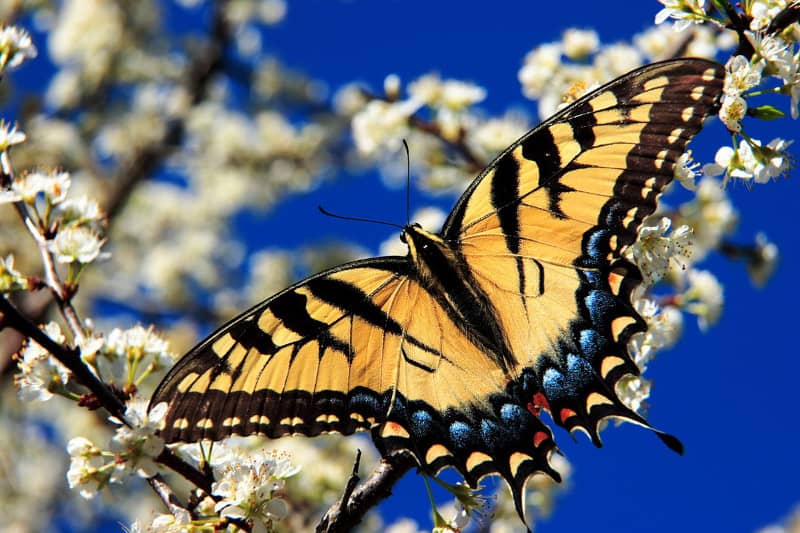
Eastern Tiger Swallowtail Facts
- This breathtaking Lepidoptera most commonly goes by the somewhat informative common name of the Eastern Tiger Swallowtail. Surprisingly, this Arthropod has no other widely accepted general name. That sets it apart from many related species.
- Within certain circles, however, it’s better known by another moniker. That’s its official, technical name. In the annals of science, it holds the name of the Papilio glaucus. Fortunately for the layperson, that’s a much simpler term than most hold.
- The stunning insect received that name due to the efforts of the esteemed Swedish zoologist, Carl Linnaeus. He accomplished the first recorded recognition of it as a separate and distinct species. That scientifically noteworthy action occurred in 1758.
- Its great visual appeal further led to it holding a unique distinction. Within the region it inhabits, it’s been named the official state butterfly of five different states. More specifically still, this marvel’s also the formal state insect of yet another state.
- Thankfully, the gorgeous Eastern Tiger Swallowtail seems to be maintaining a population base that’s both sufficient and stable. That also appears to hold true throughout the entirety of its range. The IUCN, thus has no listing for it on its Red List.
- The remarkable creature nevertheless faces the same threats as most species, at least. Many of these occur directly due to the actions of man. Habitat degradation and loss pose a possible danger. It also faces the potential threat of ongoing climate change.
Related Articles
Eastern Tiger Swallowtail Physical Description
The magnificent Eastern Tiger Swallowtail immediately captivates those who encounter it. Unlike some of its relatives, though, it does so for several reasons. Is beauty alone would suffice to impress, to be certain. Yet this wonder of Nature also ranks as a large butterfly.
It does follow one pattern common among Lepidoptera, however. That’s because, like them, it displays a moderate degree of the physiological trait of sexual dimorphism. In its specific case, though, this natural characteristic manifests in both size and appearance.
Females of the beautiful species typically attain a slightly greater wingspan. Interestingly, this also varies according to region. This measurement thus depends greatly on the area in which the individual lives. Overall, however, this averages from 3.1 – 5.5 in (7.9 – 14 cm).
Individuals from the more northern part of its range tend to be smaller than their southern counterparts. This has no apparent impact on their coloring, though. The two sexes, do, however, disintinguish themselves here, too. And the females complicate things further.
Males of the Eastern Tiger Swallowtail present predominantly bright yellow wings. Four black stripes also appear on each forewing. The outer edge also shows black, with a series of yellow dots. The hindwing shows a mixture of yellow, red, and blue spots in various places.
Yet the females show two separate distinct patterns. Some present a primarily dark gray or black background across both wings. Others displays a mainly yellow background, like the males. Faint blue areas also appear on the hindwings, and a row of orange spots.
- Kingdom: Animalia
- Phylum: Arthropoda
- Class: Insecta
- Order: Lepidoptera
- Family: Papilionidae
- Genus: Papilio
- Species: P. glaucus
Eastern Tiger Swallowtail Distribution, Habitat, and Ecology
The visual splendor that is the Eastern Tiger Swallowtail evolved as native to a limited region of the world. That area, however, is one that likely won’t surprise many people. That’s true since this marvel of Nature evolved as native to a specific portion of North America.
Even there, though, its range remains limited. It only lives within the boundaries of the United States. As its name indicates, it further lives only in the eastern part of the country. That range extends south from Vermont to Florida, and west to Texas and the plains.
This lovely Arthropod evolved as comparatively adaptible in terms of habitat requirements. Within its range, it makes its home anywhere deciduous forests appear. This includes such locations as fields, woodlands, creeks, rivers, roadsides, and gardens.
Yet this fabulous creation of evolution doesn’t stop there in its habitation practices. That’s because it does not hesitate to venture into regions of densely concentrated human populations. Due to this, it’s a common sight in city parks, private yards and gardens, as well.
The Eastern Tiger Swallowtail evolved as diurnal in its behavioral patterns. Most adults live largely solitary lives. Individuals generally fly above the tree canopy, unless descending to feed. Males also seek females by patrolling concentrations of potential food plants.
The adults also use a wide range of food sources. Intriguingly, though, they show a strong preference for the nectar from flowers that are either pink or red in color. Daisies and various legumes are popular choices, though they do not actively seem to discriminate.
Species Sharing Its Range
Check out our other articles on Africa’s Many Geological Masterpieces, Southern Darwin’s Frog, Kings Canyon, Nepenthes pervillei, Common Bottlenose Dolphin, California red-sided garter snake
